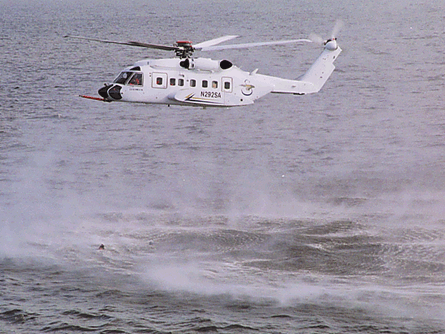The US Federal Aviation Administration and Sikorsky "are working to identify all the modes of failure that might lead to Sikorsky S-92A main gearbox oil loss, determining their probability of occurrence, and developing appropriate mitigation strategies", says the Transportation Safety Board of Canada (TSB).
The action, reported in an 18 June TSB update on crash of a Cougar Helicopters S-92A that was attempting to return to the coast of Newfoundland on 12 March, follows TSB's determination that the heavylift twin helicopter's tail rotor drive had failed during the final minutes of the flight.
Pilots about 10min earlier had reporting a loss of main gearbox oil pressure while en route to several oil platforms in the Atlantic and had reversed course and descended from 9,000ft (2,745m) to 800ft above the ocean.
An analysis of the recovered main gearbox revealed that two of three titanium oil filter bowl studs had cracked, which possibly led to the loss of oil in the gearbox and the failure indications in the cockpit. The US FAA later required all operators to change out the titanium studs for steel equivalents in an emergency airworthiness directive.
 |
|---|
© Sikorsky |
The post-crash main gearbox analysis showed that there was "no loss of main rotor drive", although the tail rotor drive gears had been "severely damaged, resulting in the loss of drive, causing it to stop producing thrust".
Although the helicopter's voice and flight data recorders failed minutes before the crash for as-yet unexplained reasons, reconstructed flight performance data from the aircraft's health and usage monitoring system (HUMS) and its flight computers reveals that the helicopter had slowed to 85kt (155km/h) as it descended through 500ft, after which pilots began shutting down both engines, "which was consistent with a tail rotor drive failure emergency", according to the TSB.
Without the anti-torque control produced by the tail rotor, a helicopter is uncontrollable in its yaw axis when the engines are producing torque. It is not yet clear why the S-92's flotation system, which had been activated in the cockpit, did not inflate upon impact with the water. Seventeen of the 18 on board died in the accident.
Although the helicopter was certificated under the FAA's rigorous Part 29 requirements, questions are arising as to whether the potential for a catastrophic loss of oil should have been anticipated before certification.
"Based on the applicable guidance material at the time of certification, the lubrication failure modes of interest were limited to the failure of external lines, fittings, valves, and coolers," says the TSB.
Although doing so was "consistent with industry experience" at the time, the TSB says that as a result of the fracture of the filter bowl mounting studs in the Cougar accident, the "certification guidance material is being reviewed".
Source: Flight International























